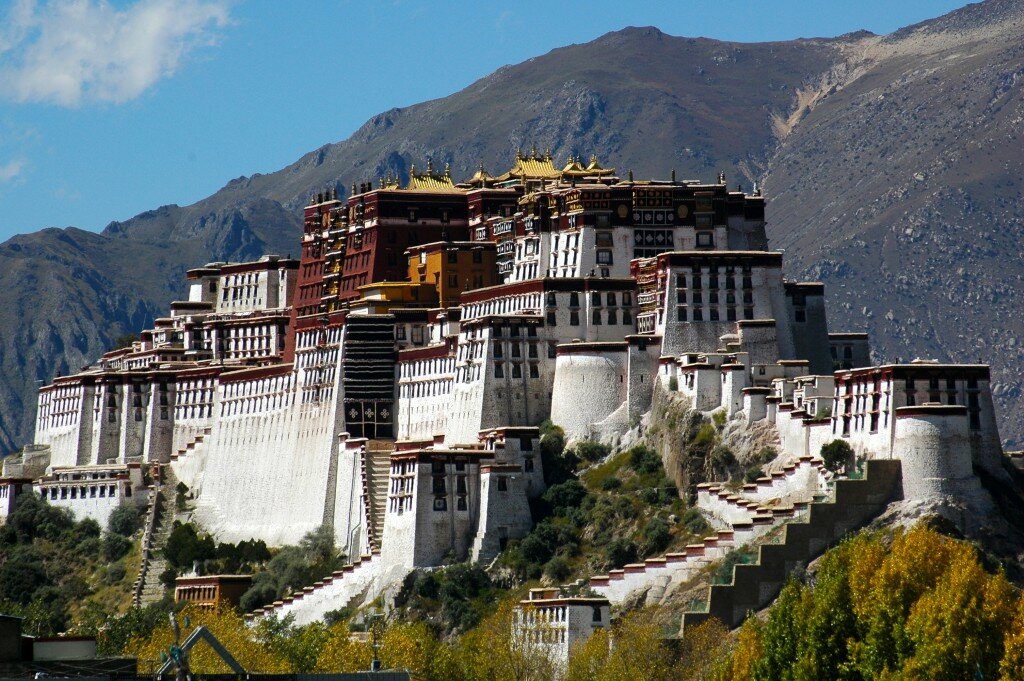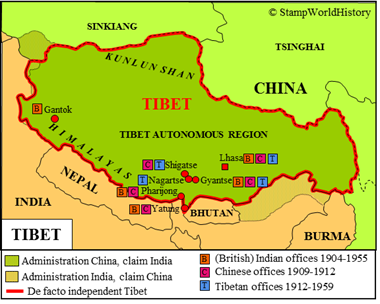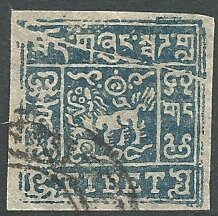བོད་

Tibet
Quick reference
General issues: Kingdom 1912-1959
Country name on general issues: Tibet
Special issues: Chinese offices in Tibet 1911
Currency: 1 Sang (Srang) = 6⅔ Trangka (Tangka) = 10 Shokang = 100 Skarung, 1½ Shokang = 1 Trangka (Tangka) 1912-1959
Population: 2 000 00 in 1911
Political history Tibet
Tibet is located in eastern Asia. In the 19th century, Tibet is ruled by the Dalai Lama under the suzerainty of China. The Dalai Lama has been, since the 17th century, the religious leader of Tibetan Buddhism and the secular leader of Tibet.
In 1904, the British send an expedition to Tibet, from British India, to counter Russian influence in Tibet and to open up Tibet for trade. The British expedition leads to the departure of the Dalai Lama from Tibet to China and a treaty allowing trade with Tibet. In subsequent treaties, the British acknowledge the Chinese suzerainty over Tibet. When the Dalai Lama is about to return to Tibet, the Chinese decide, in 1909, to establish more direct Chinese rule over Tibet by sending Chinese forces to Tibet. The Dalai Lama remains in exile, moving, however, from China to India. After the Chinese imperial Qing dynasty has fallen in 1911 the Chinese forces withdraw from Tibet in 1912.
In 1913 – the Dalai Lama having returned – Tibet proclaims its independence from China as the kingdom of Tibet. Although an independent Tibet is not recognized by China and does not gain international recognition, Tibet for the next decades has a de facto independent status. The territory under control of the Dalai Lama largely equals that of the current Tibet Autonomous Region.

Lhasa
Tibet, in 1914, signs a treaty with the British defining the borders between Tibet and British India. The agreement has been a source of conflict ever since, and in 1962 the dispute escalates into war between China and India. The war ends in a status quo ante bellum. The issue has not been resolved to this day.
After the establishment of the Peoples Republic of China, China, in 1950, invades Tibet once again. Terms are agreed upon with the Dalai Lama that Tibet will be a self governing part of the China, the Dalai Lama recognizing Chinese sovereignty. In 1959, Tibet revolts against Chinese sovereignty, a revolt that is crushed by the Chinese. The Dalai Lama goes into exile to form a government in exile in India. The Chinese establish more direct Chinese rule, although a form of self government is retained as Tibet, in 1965, becomes the Tibet Autonomous Region, called Xigang in modern pinyin.
Postal history Tibet
The first post offices in Tibet are opened following the British expedition into Tibet in 1904 and are run by the British Indian postal service using the stamps of British India. These post offices were located in Lhasa[1]Open only in 1904. , Pharijong, Gyantse, Yatung and Gartok. After the independence of British India, these offices are taken over by the postal service of India. The offices are closed in 1955.
When China moves into Tibet in 1909, they set up a postal service of their own. Post offices are opened in Lhasa, Yatung, Gyantse, Shigatse and Pharijong. At first, Chinese stamps are used. In 1911, stamps are issued for use in Tibet. These are previous Chinese issues overprinted with a new face value in Chinese, English and Tibetan. The currency used is the currency of British India. It has been suggested that this may have been because the Indian rupee was the most popular currency in Tibet.
Tibet has issued stamps from 1912 to 1959. The Tibetan postal service had post offices in Lhasa, Shigatse, Gyantse and Nagartse. All issues from Tibet are of local design and print and exist in many varieties. Three designs have been used. Tibetan stamps were used for domestic mail, international mail being franked with (British) Indian stamps and processed through the (British) Indian post offices until the 1950’s. From 1951, the Chinese again set up a postal service that eventually takes over the Tibetan postal service, the last Tibetan post offices being closed in 1959.
A set of official stamps and a set of telegraph stamps that are said to be used postally are disputed. Stamps issued by the government in exile, in the 1970’s, are considered to be propaganda labels.
Album pages
← Previous page: ThailandNext page: Timor →



